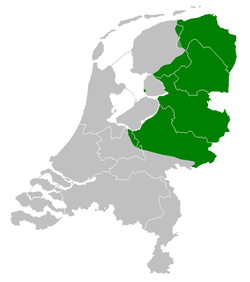This article needs additional citations for verification .(December 2009) |
| West Low German | |
|---|---|
| Native to | Germany, Netherlands, Southern Denmark |
| Speakers | Native: 300,000 (2016) [1] L2: 2.2 million [1] |
Indo-European
| |
| Language codes | |
| ISO 639-2 | nds for Low German |
| ISO 639-3 | Variously: nds – (partial) wep – Westphalian frs – Eastern Frisian gos – Gronings stl – Stellingwerfs drt – Drents twd – Twents act – Achterhoeks sdz – Sallands vel – Veluws |
| Glottolog | west2357 |
 West Low German area in yellow | |
Low Saxon (Dutch : Nedersaksisch), also known as West Low German (German : Westniederdeutsch [2] ) are a group of Low German dialects spoken in parts of the Netherlands, northwestern Germany and southern Denmark (in North Schleswig by parts of the German-speaking minority). It is one of two dialect groups, the other being East Low German.
